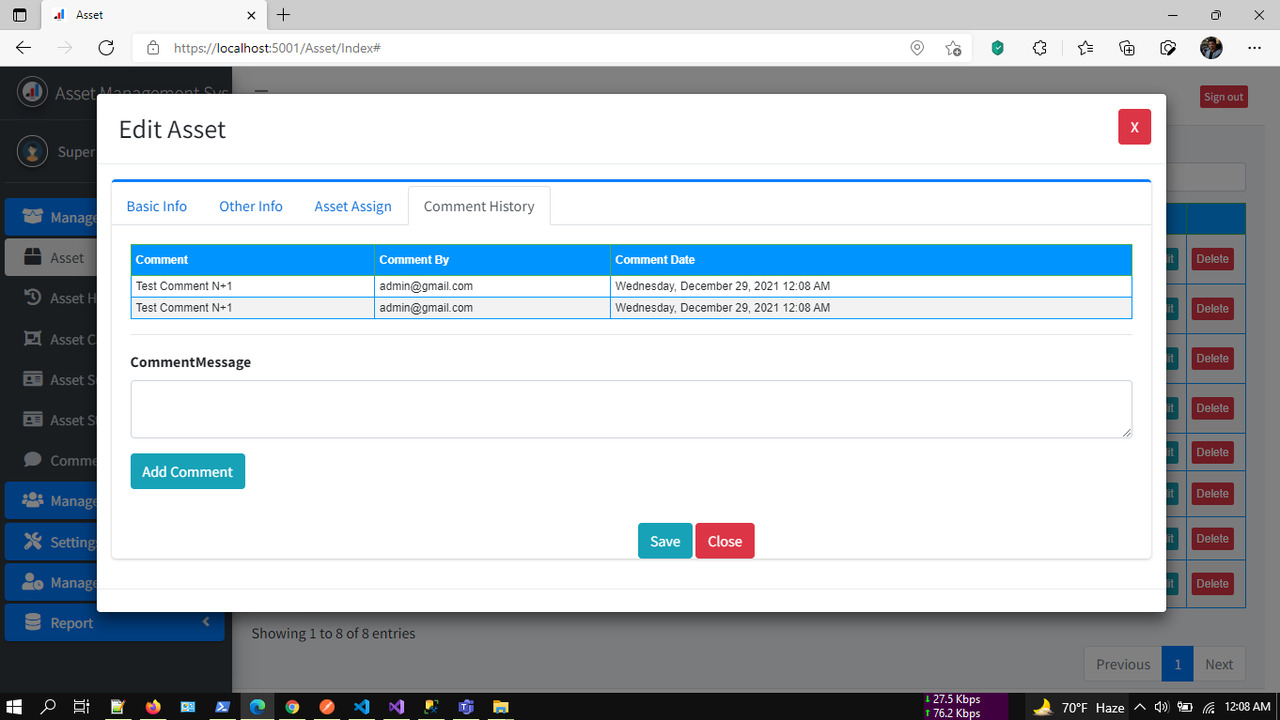No products in the cart.
Implementing v2.0.0 Asset Management System with Barcode Using ASP.NET Core and EF Core
Asset Administration System (AMS) is a multi-functional full internet utility developed utilizing ASP.NET Core and EF Core code first expertise. It lets you handle every kind of property on your firm via correct monitoring and a dynamic reporting system. You may handle property out there in your workplace, like computer systems, Printers, Moveable Onerous-disk, Pen-drive, and so on. You may monitor the historical past of property as effectively.
In today's fast-paced business environment, effective asset management is crucial for maintaining operational efficiency and reducing unnecessary costs. The Asset Management System (AMS) v2.0.0, developed with ASP.NET Core, EF Core, and .NET Core 6.0, presents a sophisticated solution for tracking and managing company assets through advanced barcode technology and dynamic reporting.
Introduction to Asset Management System (AMS) v2.0.0
AMS v2.0.0 is a multi-functional web application designed to facilitate comprehensive asset management. This system allows for precise tracking and dynamic reporting of various assets such as computers, printers, portable hard disks, and pen drives, among others.
Key Features of AMS v2.0.0
- Barcode Integration: Enhances the efficiency of asset tracking and inventory management.
- Dynamic Reporting: Offers real-time insights into asset utilization and performance.
- History Tracking: Maintains a detailed history of asset movements and maintenance.
Technologies Behind AMS: ASP.NET Core, EF Core, and .NET Core 6.0
The choice of ASP.NET Core and EF Core for the development of AMS underscores a commitment to robustness, security, and scalability. Leveraging the .NET Core 6.0 framework, AMS is positioned at the forefront of modern web application development.
Setting Up the Environment for AMS Development
The development of AMS requires a well-prepared environment, including the installation of ASP.NET Core, .NET Core 6.0, and EF Core.
System Requirements for ASP.NET Core and EF Core
- ASP.NET Core Runtime
- .NET Core 6.0 SDK
- Visual Studio 2019 or later with the ASP.NET and web development workload
- SQL Server for the database backend
Installing and Configuring ASP.NET Core and .NET Core 6.0
Installation guides for ASP.NET Core and .NET Core 6.0 are available on the official Microsoft documentation website. These guides provide step-by-step instructions for setting up your development environment.
Building the AMS: A Step-by-Step Guide
Developing AMS involves several key steps, from designing the database schema using the EF Core code-first approach to implementing barcode functionality for asset tracking.
Designing the Database Schema with EF Core Code First Approach
The EF Core code-first approach allows developers to define database schemas directly in code, offering flexibility and ease of modifications. This method facilitates the creation of a database that accurately reflects the needs of AMS.
Implementing Barcode Functionality for Asset Tracking
Integrating barcode functionality streamlines the process of asset registration and tracking. ASP.NET Core provides the tools necessary to implement barcode scanning features, significantly enhancing the usability of AMS.
Managing Assets with AMS
AMS offers comprehensive tools for asset registration, categorization, and tracking. The system's intuitive interface simplifies the management of asset lifecycles, from acquisition to disposal.
Dynamic Reporting and Analytics in AMS
AMS's dynamic reporting capabilities enable users to generate detailed reports on asset utilization, performance, and maintenance schedules. Customizable dashboards provide real-time insights, facilitating informed decision-making.
Security Measures and Best Practices
Security is paramount in AMS. Implementing authentication, authorization, and data encryption protocols ensures that sensitive asset information is protected against unauthorized access and breaches.
Deployment and Maintenance of AMS
Deploying AMS on a web server requires careful planning to ensure scalability and performance optimization. Regular system audits and updates are crucial for maintaining the system's integrity and responsiveness.
Training and User Adoption
Successful implementation of AMS also depends on effective user training and adoption strategies. Developing comprehensive user manuals and conducting training sessions ensures that staff can fully leverage the system's capabilities.
Future Directions for AMS Development
Looking ahead, AMS will continue to evolve, incorporating new features such as IoT integration for enhanced asset tracking and AI for predictive maintenance. These advancements promise to further revolutionize asset management practices.
Conclusion: Enhancing Asset Management with AMS v2.0.0
Implementing the v2.0.0 Asset Management System using ASP.NET Core, EF Core, and .NET Core 6.0 offers businesses a powerful tool for managing their assets efficiently. With barcode integration, dynamic reporting, and a strong emphasis on security, AMS v2.0.0 is poised to become an indispensable asset for companies aiming to optimize their operational efficiency and reduce costs.






